Report on Effective Caring: Techniques, Factors, and Constraints
VerifiedAdded on 2023/01/17
|8
|2888
|45
Report
AI Summary
This report provides a comprehensive overview of effective caring practices, focusing on the techniques and factors that contribute to a better quality of life for individuals. It explores various caring techniques such as showing approval, communication, creating trust, and observation, highlighting their importance in providing beneficial services to patients. The report also examines the key factors influencing quality of life, including choices, privacy, guidance, and social interaction. Furthermore, it identifies the constraints that can affect positive caring, such as developmental progress, language and cultural differences, attitude, and emotional distress. The report emphasizes the significance of understanding and addressing these barriers to ensure effective care and improve patient outcomes. The document is contributed by a student to be published on the website Desklib, which provides all the necessary AI based study tools for students.
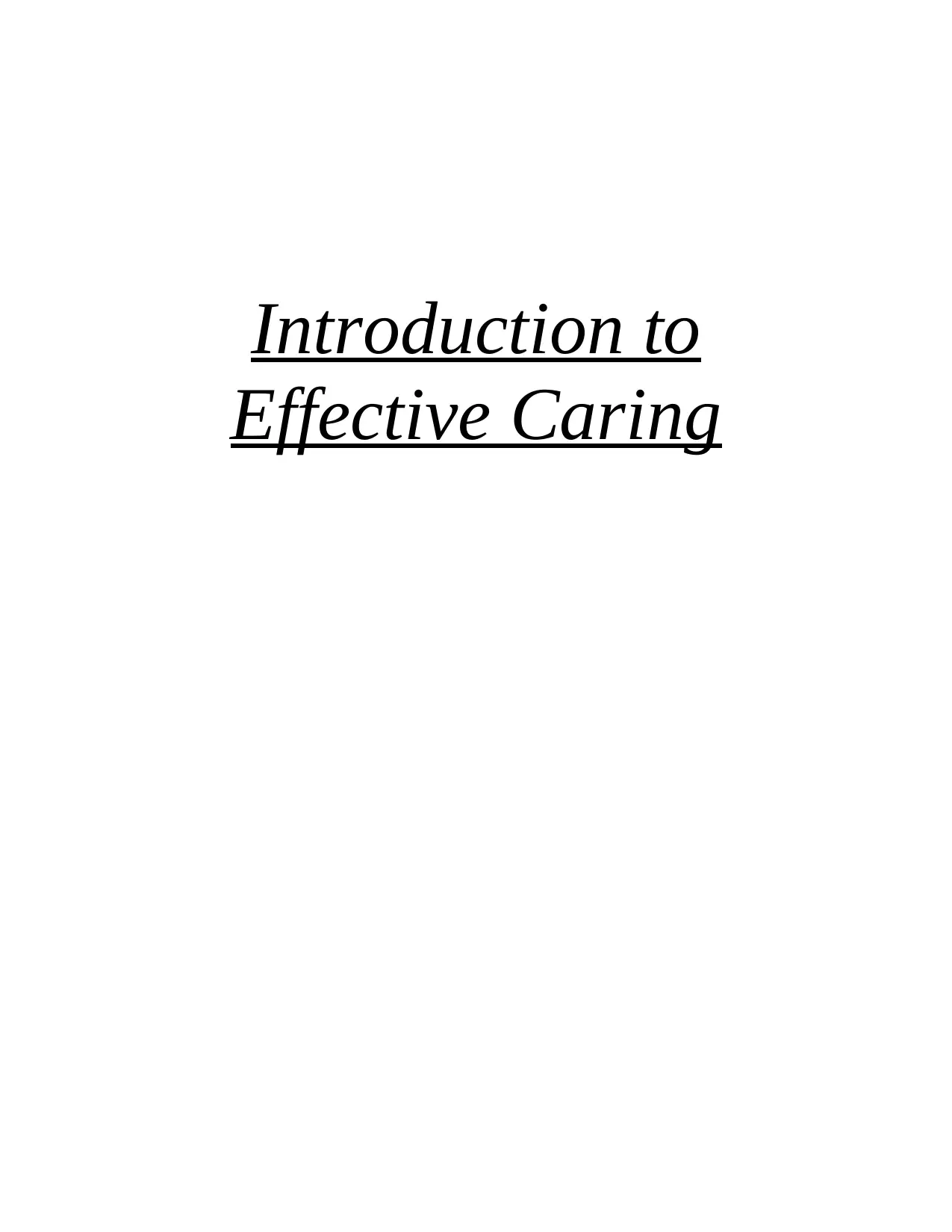
Introduction to
Effective Caring
Effective Caring
Paraphrase This Document
Need a fresh take? Get an instant paraphrase of this document with our AI Paraphraser

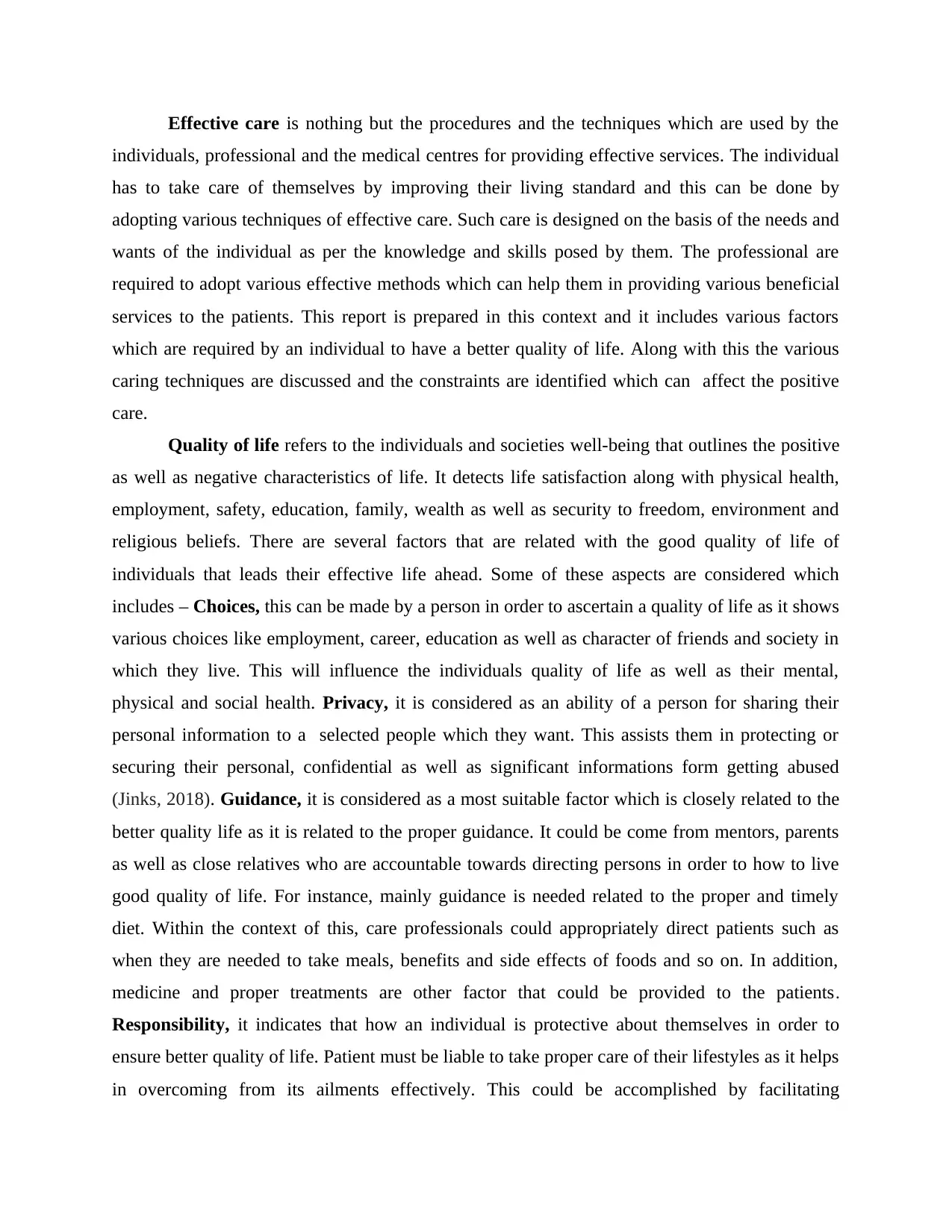
Effective care is nothing but the procedures and the techniques which are used by the
individuals, professional and the medical centres for providing effective services. The individual
has to take care of themselves by improving their living standard and this can be done by
adopting various techniques of effective care. Such care is designed on the basis of the needs and
wants of the individual as per the knowledge and skills posed by them. The professional are
required to adopt various effective methods which can help them in providing various beneficial
services to the patients. This report is prepared in this context and it includes various factors
which are required by an individual to have a better quality of life. Along with this the various
caring techniques are discussed and the constraints are identified which can affect the positive
care.
Quality of life refers to the individuals and societies well-being that outlines the positive
as well as negative characteristics of life. It detects life satisfaction along with physical health,
employment, safety, education, family, wealth as well as security to freedom, environment and
religious beliefs. There are several factors that are related with the good quality of life of
individuals that leads their effective life ahead. Some of these aspects are considered which
includes – Choices, this can be made by a person in order to ascertain a quality of life as it shows
various choices like employment, career, education as well as character of friends and society in
which they live. This will influence the individuals quality of life as well as their mental,
physical and social health. Privacy, it is considered as an ability of a person for sharing their
personal information to a selected people which they want. This assists them in protecting or
securing their personal, confidential as well as significant informations form getting abused
(Jinks, 2018). Guidance, it is considered as a most suitable factor which is closely related to the
better quality life as it is related to the proper guidance. It could be come from mentors, parents
as well as close relatives who are accountable towards directing persons in order to how to live
good quality of life. For instance, mainly guidance is needed related to the proper and timely
diet. Within the context of this, care professionals could appropriately direct patients such as
when they are needed to take meals, benefits and side effects of foods and so on. In addition,
medicine and proper treatments are other factor that could be provided to the patients.
Responsibility, it indicates that how an individual is protective about themselves in order to
ensure better quality of life. Patient must be liable to take proper care of their lifestyles as it helps
in overcoming from its ailments effectively. This could be accomplished by facilitating
individuals, professional and the medical centres for providing effective services. The individual
has to take care of themselves by improving their living standard and this can be done by
adopting various techniques of effective care. Such care is designed on the basis of the needs and
wants of the individual as per the knowledge and skills posed by them. The professional are
required to adopt various effective methods which can help them in providing various beneficial
services to the patients. This report is prepared in this context and it includes various factors
which are required by an individual to have a better quality of life. Along with this the various
caring techniques are discussed and the constraints are identified which can affect the positive
care.
Quality of life refers to the individuals and societies well-being that outlines the positive
as well as negative characteristics of life. It detects life satisfaction along with physical health,
employment, safety, education, family, wealth as well as security to freedom, environment and
religious beliefs. There are several factors that are related with the good quality of life of
individuals that leads their effective life ahead. Some of these aspects are considered which
includes – Choices, this can be made by a person in order to ascertain a quality of life as it shows
various choices like employment, career, education as well as character of friends and society in
which they live. This will influence the individuals quality of life as well as their mental,
physical and social health. Privacy, it is considered as an ability of a person for sharing their
personal information to a selected people which they want. This assists them in protecting or
securing their personal, confidential as well as significant informations form getting abused
(Jinks, 2018). Guidance, it is considered as a most suitable factor which is closely related to the
better quality life as it is related to the proper guidance. It could be come from mentors, parents
as well as close relatives who are accountable towards directing persons in order to how to live
good quality of life. For instance, mainly guidance is needed related to the proper and timely
diet. Within the context of this, care professionals could appropriately direct patients such as
when they are needed to take meals, benefits and side effects of foods and so on. In addition,
medicine and proper treatments are other factor that could be provided to the patients.
Responsibility, it indicates that how an individual is protective about themselves in order to
ensure better quality of life. Patient must be liable to take proper care of their lifestyles as it helps
in overcoming from its ailments effectively. This could be accomplished by facilitating
⊘ This is a preview!⊘
Do you want full access?
Subscribe today to unlock all pages.

Trusted by 1+ million students worldwide
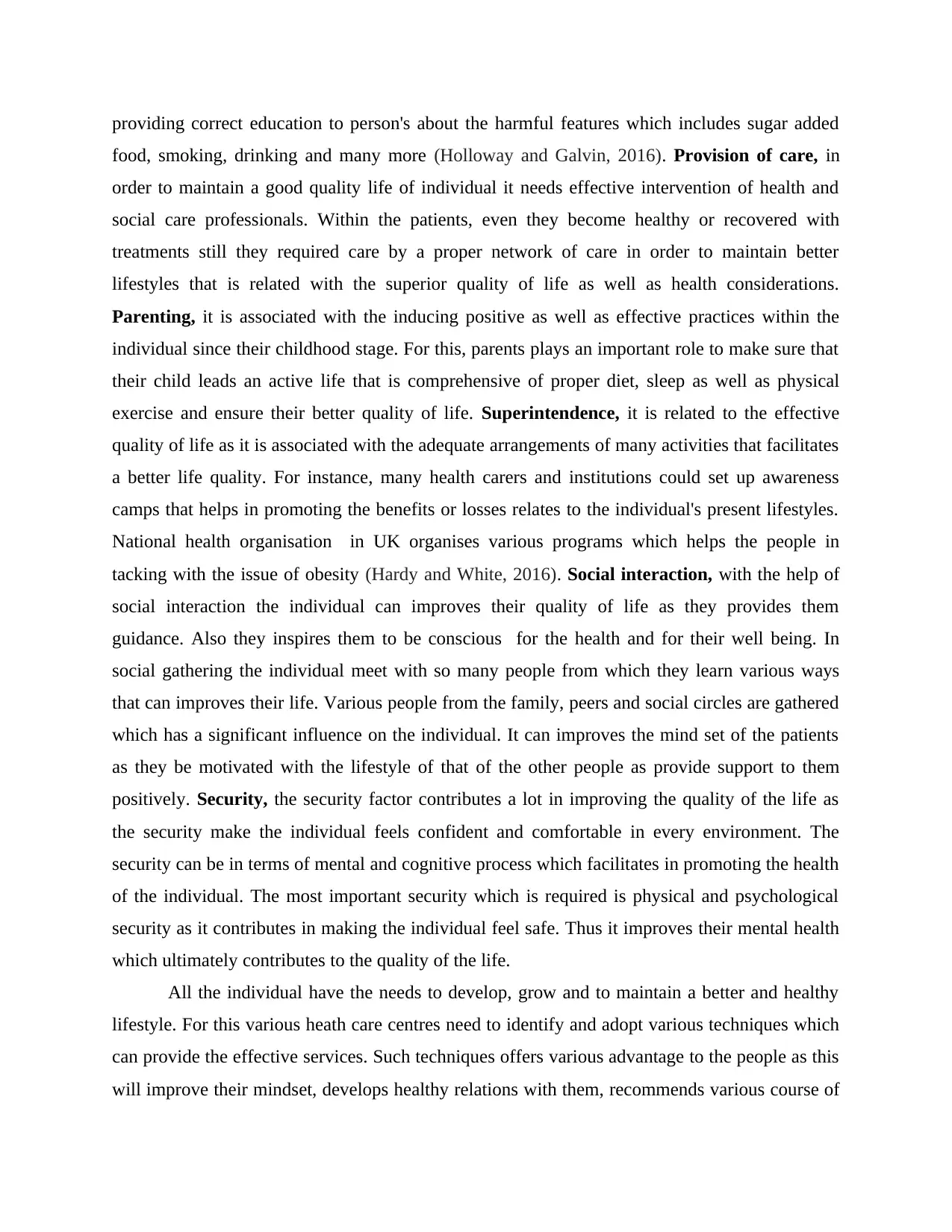
providing correct education to person's about the harmful features which includes sugar added
food, smoking, drinking and many more (Holloway and Galvin, 2016). Provision of care, in
order to maintain a good quality life of individual it needs effective intervention of health and
social care professionals. Within the patients, even they become healthy or recovered with
treatments still they required care by a proper network of care in order to maintain better
lifestyles that is related with the superior quality of life as well as health considerations.
Parenting, it is associated with the inducing positive as well as effective practices within the
individual since their childhood stage. For this, parents plays an important role to make sure that
their child leads an active life that is comprehensive of proper diet, sleep as well as physical
exercise and ensure their better quality of life. Superintendence, it is related to the effective
quality of life as it is associated with the adequate arrangements of many activities that facilitates
a better life quality. For instance, many health carers and institutions could set up awareness
camps that helps in promoting the benefits or losses relates to the individual's present lifestyles.
National health organisation in UK organises various programs which helps the people in
tacking with the issue of obesity (Hardy and White, 2016). Social interaction, with the help of
social interaction the individual can improves their quality of life as they provides them
guidance. Also they inspires them to be conscious for the health and for their well being. In
social gathering the individual meet with so many people from which they learn various ways
that can improves their life. Various people from the family, peers and social circles are gathered
which has a significant influence on the individual. It can improves the mind set of the patients
as they be motivated with the lifestyle of that of the other people as provide support to them
positively. Security, the security factor contributes a lot in improving the quality of the life as
the security make the individual feels confident and comfortable in every environment. The
security can be in terms of mental and cognitive process which facilitates in promoting the health
of the individual. The most important security which is required is physical and psychological
security as it contributes in making the individual feel safe. Thus it improves their mental health
which ultimately contributes to the quality of the life.
All the individual have the needs to develop, grow and to maintain a better and healthy
lifestyle. For this various heath care centres need to identify and adopt various techniques which
can provide the effective services. Such techniques offers various advantage to the people as this
will improve their mindset, develops healthy relations with them, recommends various course of
food, smoking, drinking and many more (Holloway and Galvin, 2016). Provision of care, in
order to maintain a good quality life of individual it needs effective intervention of health and
social care professionals. Within the patients, even they become healthy or recovered with
treatments still they required care by a proper network of care in order to maintain better
lifestyles that is related with the superior quality of life as well as health considerations.
Parenting, it is associated with the inducing positive as well as effective practices within the
individual since their childhood stage. For this, parents plays an important role to make sure that
their child leads an active life that is comprehensive of proper diet, sleep as well as physical
exercise and ensure their better quality of life. Superintendence, it is related to the effective
quality of life as it is associated with the adequate arrangements of many activities that facilitates
a better life quality. For instance, many health carers and institutions could set up awareness
camps that helps in promoting the benefits or losses relates to the individual's present lifestyles.
National health organisation in UK organises various programs which helps the people in
tacking with the issue of obesity (Hardy and White, 2016). Social interaction, with the help of
social interaction the individual can improves their quality of life as they provides them
guidance. Also they inspires them to be conscious for the health and for their well being. In
social gathering the individual meet with so many people from which they learn various ways
that can improves their life. Various people from the family, peers and social circles are gathered
which has a significant influence on the individual. It can improves the mind set of the patients
as they be motivated with the lifestyle of that of the other people as provide support to them
positively. Security, the security factor contributes a lot in improving the quality of the life as
the security make the individual feels confident and comfortable in every environment. The
security can be in terms of mental and cognitive process which facilitates in promoting the health
of the individual. The most important security which is required is physical and psychological
security as it contributes in making the individual feel safe. Thus it improves their mental health
which ultimately contributes to the quality of the life.
All the individual have the needs to develop, grow and to maintain a better and healthy
lifestyle. For this various heath care centres need to identify and adopt various techniques which
can provide the effective services. Such techniques offers various advantage to the people as this
will improve their mindset, develops healthy relations with them, recommends various course of
Paraphrase This Document
Need a fresh take? Get an instant paraphrase of this document with our AI Paraphraser
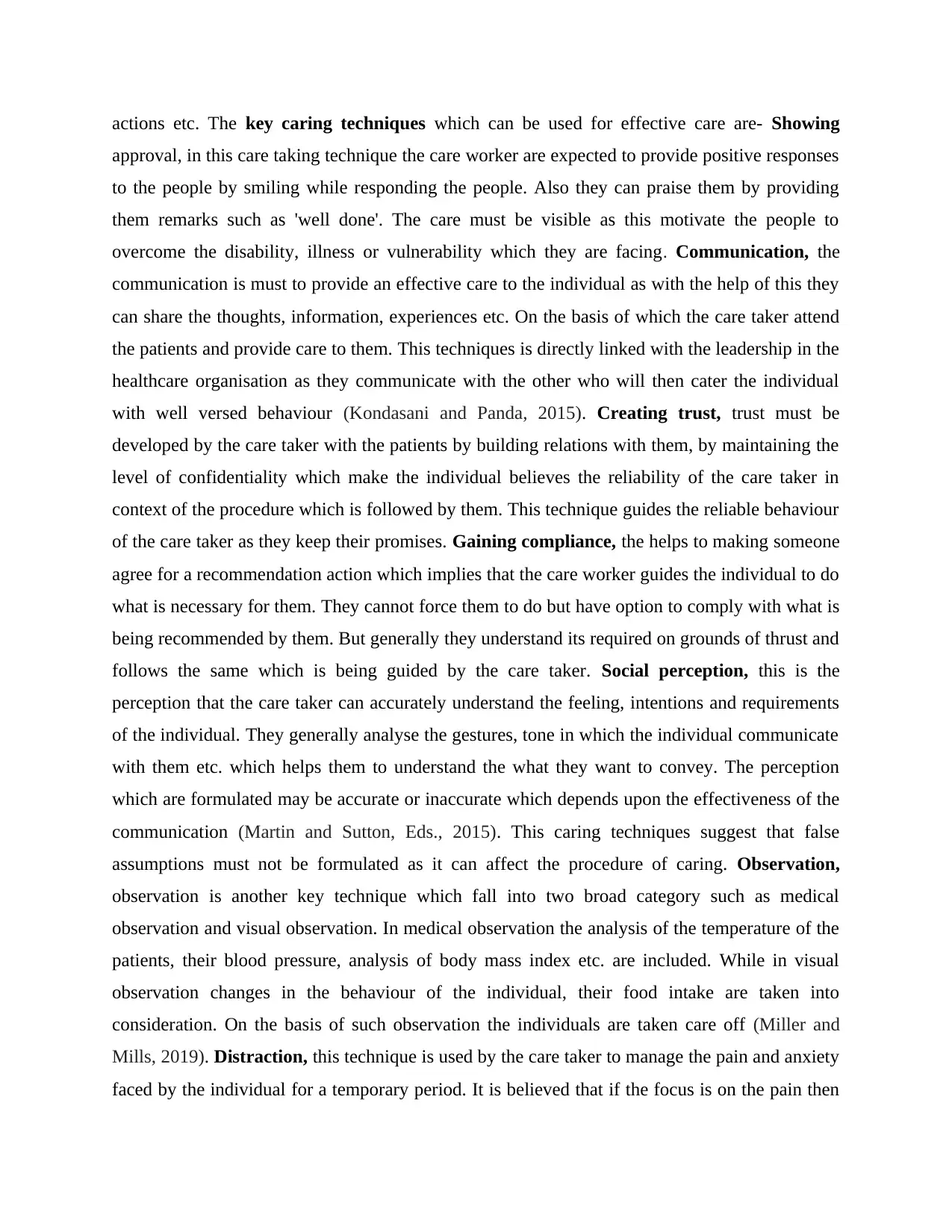
actions etc. The key caring techniques which can be used for effective care are- Showing
approval, in this care taking technique the care worker are expected to provide positive responses
to the people by smiling while responding the people. Also they can praise them by providing
them remarks such as 'well done'. The care must be visible as this motivate the people to
overcome the disability, illness or vulnerability which they are facing. Communication, the
communication is must to provide an effective care to the individual as with the help of this they
can share the thoughts, information, experiences etc. On the basis of which the care taker attend
the patients and provide care to them. This techniques is directly linked with the leadership in the
healthcare organisation as they communicate with the other who will then cater the individual
with well versed behaviour (Kondasani and Panda, 2015). Creating trust, trust must be
developed by the care taker with the patients by building relations with them, by maintaining the
level of confidentiality which make the individual believes the reliability of the care taker in
context of the procedure which is followed by them. This technique guides the reliable behaviour
of the care taker as they keep their promises. Gaining compliance, the helps to making someone
agree for a recommendation action which implies that the care worker guides the individual to do
what is necessary for them. They cannot force them to do but have option to comply with what is
being recommended by them. But generally they understand its required on grounds of thrust and
follows the same which is being guided by the care taker. Social perception, this is the
perception that the care taker can accurately understand the feeling, intentions and requirements
of the individual. They generally analyse the gestures, tone in which the individual communicate
with them etc. which helps them to understand the what they want to convey. The perception
which are formulated may be accurate or inaccurate which depends upon the effectiveness of the
communication (Martin and Sutton, Eds., 2015). This caring techniques suggest that false
assumptions must not be formulated as it can affect the procedure of caring. Observation,
observation is another key technique which fall into two broad category such as medical
observation and visual observation. In medical observation the analysis of the temperature of the
patients, their blood pressure, analysis of body mass index etc. are included. While in visual
observation changes in the behaviour of the individual, their food intake are taken into
consideration. On the basis of such observation the individuals are taken care off (Miller and
Mills, 2019). Distraction, this technique is used by the care taker to manage the pain and anxiety
faced by the individual for a temporary period. It is believed that if the focus is on the pain then
approval, in this care taking technique the care worker are expected to provide positive responses
to the people by smiling while responding the people. Also they can praise them by providing
them remarks such as 'well done'. The care must be visible as this motivate the people to
overcome the disability, illness or vulnerability which they are facing. Communication, the
communication is must to provide an effective care to the individual as with the help of this they
can share the thoughts, information, experiences etc. On the basis of which the care taker attend
the patients and provide care to them. This techniques is directly linked with the leadership in the
healthcare organisation as they communicate with the other who will then cater the individual
with well versed behaviour (Kondasani and Panda, 2015). Creating trust, trust must be
developed by the care taker with the patients by building relations with them, by maintaining the
level of confidentiality which make the individual believes the reliability of the care taker in
context of the procedure which is followed by them. This technique guides the reliable behaviour
of the care taker as they keep their promises. Gaining compliance, the helps to making someone
agree for a recommendation action which implies that the care worker guides the individual to do
what is necessary for them. They cannot force them to do but have option to comply with what is
being recommended by them. But generally they understand its required on grounds of thrust and
follows the same which is being guided by the care taker. Social perception, this is the
perception that the care taker can accurately understand the feeling, intentions and requirements
of the individual. They generally analyse the gestures, tone in which the individual communicate
with them etc. which helps them to understand the what they want to convey. The perception
which are formulated may be accurate or inaccurate which depends upon the effectiveness of the
communication (Martin and Sutton, Eds., 2015). This caring techniques suggest that false
assumptions must not be formulated as it can affect the procedure of caring. Observation,
observation is another key technique which fall into two broad category such as medical
observation and visual observation. In medical observation the analysis of the temperature of the
patients, their blood pressure, analysis of body mass index etc. are included. While in visual
observation changes in the behaviour of the individual, their food intake are taken into
consideration. On the basis of such observation the individuals are taken care off (Miller and
Mills, 2019). Distraction, this technique is used by the care taker to manage the pain and anxiety
faced by the individual for a temporary period. It is believed that if the focus is on the pain then
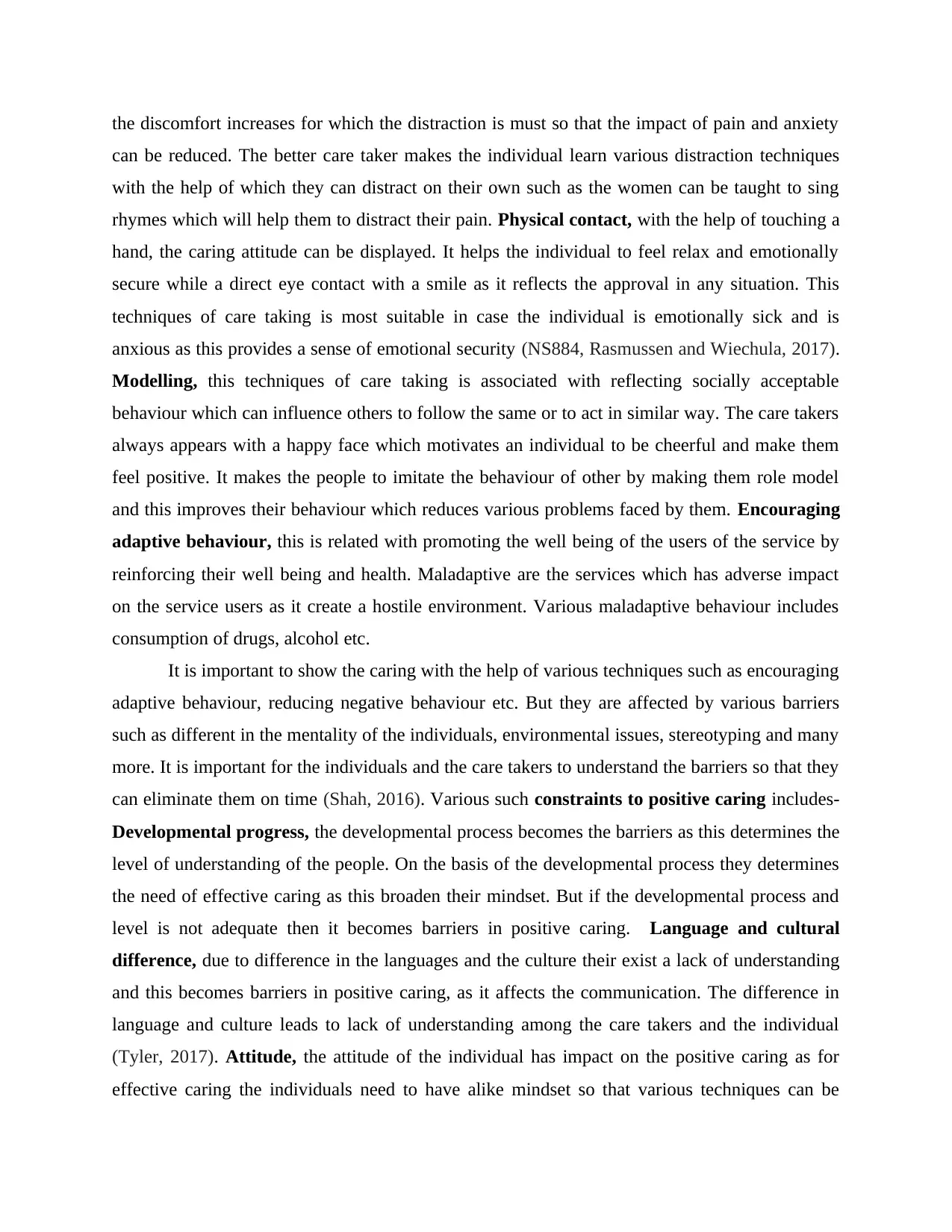
the discomfort increases for which the distraction is must so that the impact of pain and anxiety
can be reduced. The better care taker makes the individual learn various distraction techniques
with the help of which they can distract on their own such as the women can be taught to sing
rhymes which will help them to distract their pain. Physical contact, with the help of touching a
hand, the caring attitude can be displayed. It helps the individual to feel relax and emotionally
secure while a direct eye contact with a smile as it reflects the approval in any situation. This
techniques of care taking is most suitable in case the individual is emotionally sick and is
anxious as this provides a sense of emotional security (NS884, Rasmussen and Wiechula, 2017).
Modelling, this techniques of care taking is associated with reflecting socially acceptable
behaviour which can influence others to follow the same or to act in similar way. The care takers
always appears with a happy face which motivates an individual to be cheerful and make them
feel positive. It makes the people to imitate the behaviour of other by making them role model
and this improves their behaviour which reduces various problems faced by them. Encouraging
adaptive behaviour, this is related with promoting the well being of the users of the service by
reinforcing their well being and health. Maladaptive are the services which has adverse impact
on the service users as it create a hostile environment. Various maladaptive behaviour includes
consumption of drugs, alcohol etc.
It is important to show the caring with the help of various techniques such as encouraging
adaptive behaviour, reducing negative behaviour etc. But they are affected by various barriers
such as different in the mentality of the individuals, environmental issues, stereotyping and many
more. It is important for the individuals and the care takers to understand the barriers so that they
can eliminate them on time (Shah, 2016). Various such constraints to positive caring includes-
Developmental progress, the developmental process becomes the barriers as this determines the
level of understanding of the people. On the basis of the developmental process they determines
the need of effective caring as this broaden their mindset. But if the developmental process and
level is not adequate then it becomes barriers in positive caring. Language and cultural
difference, due to difference in the languages and the culture their exist a lack of understanding
and this becomes barriers in positive caring, as it affects the communication. The difference in
language and culture leads to lack of understanding among the care takers and the individual
(Tyler, 2017). Attitude, the attitude of the individual has impact on the positive caring as for
effective caring the individuals need to have alike mindset so that various techniques can be
can be reduced. The better care taker makes the individual learn various distraction techniques
with the help of which they can distract on their own such as the women can be taught to sing
rhymes which will help them to distract their pain. Physical contact, with the help of touching a
hand, the caring attitude can be displayed. It helps the individual to feel relax and emotionally
secure while a direct eye contact with a smile as it reflects the approval in any situation. This
techniques of care taking is most suitable in case the individual is emotionally sick and is
anxious as this provides a sense of emotional security (NS884, Rasmussen and Wiechula, 2017).
Modelling, this techniques of care taking is associated with reflecting socially acceptable
behaviour which can influence others to follow the same or to act in similar way. The care takers
always appears with a happy face which motivates an individual to be cheerful and make them
feel positive. It makes the people to imitate the behaviour of other by making them role model
and this improves their behaviour which reduces various problems faced by them. Encouraging
adaptive behaviour, this is related with promoting the well being of the users of the service by
reinforcing their well being and health. Maladaptive are the services which has adverse impact
on the service users as it create a hostile environment. Various maladaptive behaviour includes
consumption of drugs, alcohol etc.
It is important to show the caring with the help of various techniques such as encouraging
adaptive behaviour, reducing negative behaviour etc. But they are affected by various barriers
such as different in the mentality of the individuals, environmental issues, stereotyping and many
more. It is important for the individuals and the care takers to understand the barriers so that they
can eliminate them on time (Shah, 2016). Various such constraints to positive caring includes-
Developmental progress, the developmental process becomes the barriers as this determines the
level of understanding of the people. On the basis of the developmental process they determines
the need of effective caring as this broaden their mindset. But if the developmental process and
level is not adequate then it becomes barriers in positive caring. Language and cultural
difference, due to difference in the languages and the culture their exist a lack of understanding
and this becomes barriers in positive caring, as it affects the communication. The difference in
language and culture leads to lack of understanding among the care takers and the individual
(Tyler, 2017). Attitude, the attitude of the individual has impact on the positive caring as for
effective caring the individuals need to have alike mindset so that various techniques can be
⊘ This is a preview!⊘
Do you want full access?
Subscribe today to unlock all pages.

Trusted by 1+ million students worldwide
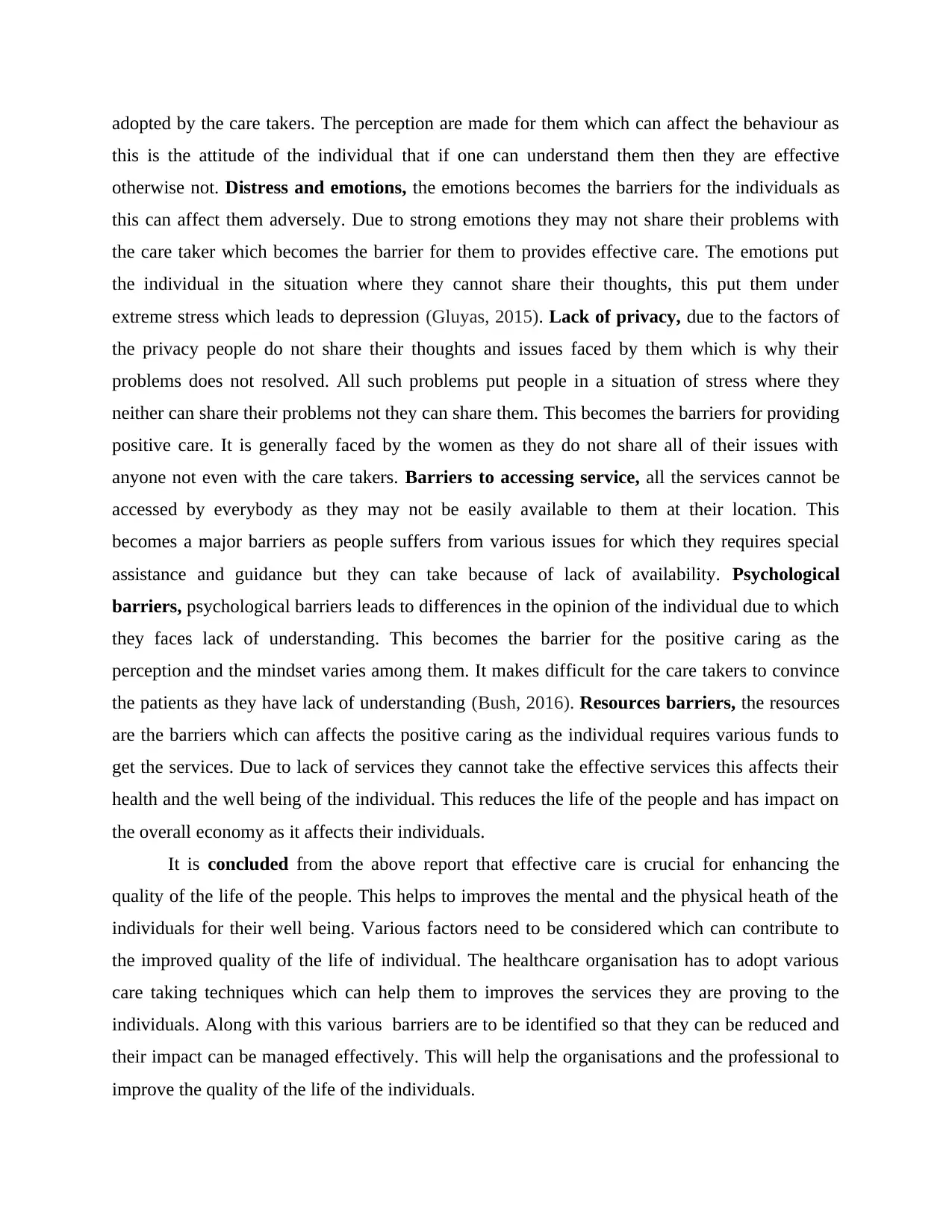
adopted by the care takers. The perception are made for them which can affect the behaviour as
this is the attitude of the individual that if one can understand them then they are effective
otherwise not. Distress and emotions, the emotions becomes the barriers for the individuals as
this can affect them adversely. Due to strong emotions they may not share their problems with
the care taker which becomes the barrier for them to provides effective care. The emotions put
the individual in the situation where they cannot share their thoughts, this put them under
extreme stress which leads to depression (Gluyas, 2015). Lack of privacy, due to the factors of
the privacy people do not share their thoughts and issues faced by them which is why their
problems does not resolved. All such problems put people in a situation of stress where they
neither can share their problems not they can share them. This becomes the barriers for providing
positive care. It is generally faced by the women as they do not share all of their issues with
anyone not even with the care takers. Barriers to accessing service, all the services cannot be
accessed by everybody as they may not be easily available to them at their location. This
becomes a major barriers as people suffers from various issues for which they requires special
assistance and guidance but they can take because of lack of availability. Psychological
barriers, psychological barriers leads to differences in the opinion of the individual due to which
they faces lack of understanding. This becomes the barrier for the positive caring as the
perception and the mindset varies among them. It makes difficult for the care takers to convince
the patients as they have lack of understanding (Bush, 2016). Resources barriers, the resources
are the barriers which can affects the positive caring as the individual requires various funds to
get the services. Due to lack of services they cannot take the effective services this affects their
health and the well being of the individual. This reduces the life of the people and has impact on
the overall economy as it affects their individuals.
It is concluded from the above report that effective care is crucial for enhancing the
quality of the life of the people. This helps to improves the mental and the physical heath of the
individuals for their well being. Various factors need to be considered which can contribute to
the improved quality of the life of individual. The healthcare organisation has to adopt various
care taking techniques which can help them to improves the services they are proving to the
individuals. Along with this various barriers are to be identified so that they can be reduced and
their impact can be managed effectively. This will help the organisations and the professional to
improve the quality of the life of the individuals.
this is the attitude of the individual that if one can understand them then they are effective
otherwise not. Distress and emotions, the emotions becomes the barriers for the individuals as
this can affect them adversely. Due to strong emotions they may not share their problems with
the care taker which becomes the barrier for them to provides effective care. The emotions put
the individual in the situation where they cannot share their thoughts, this put them under
extreme stress which leads to depression (Gluyas, 2015). Lack of privacy, due to the factors of
the privacy people do not share their thoughts and issues faced by them which is why their
problems does not resolved. All such problems put people in a situation of stress where they
neither can share their problems not they can share them. This becomes the barriers for providing
positive care. It is generally faced by the women as they do not share all of their issues with
anyone not even with the care takers. Barriers to accessing service, all the services cannot be
accessed by everybody as they may not be easily available to them at their location. This
becomes a major barriers as people suffers from various issues for which they requires special
assistance and guidance but they can take because of lack of availability. Psychological
barriers, psychological barriers leads to differences in the opinion of the individual due to which
they faces lack of understanding. This becomes the barrier for the positive caring as the
perception and the mindset varies among them. It makes difficult for the care takers to convince
the patients as they have lack of understanding (Bush, 2016). Resources barriers, the resources
are the barriers which can affects the positive caring as the individual requires various funds to
get the services. Due to lack of services they cannot take the effective services this affects their
health and the well being of the individual. This reduces the life of the people and has impact on
the overall economy as it affects their individuals.
It is concluded from the above report that effective care is crucial for enhancing the
quality of the life of the people. This helps to improves the mental and the physical heath of the
individuals for their well being. Various factors need to be considered which can contribute to
the improved quality of the life of individual. The healthcare organisation has to adopt various
care taking techniques which can help them to improves the services they are proving to the
individuals. Along with this various barriers are to be identified so that they can be reduced and
their impact can be managed effectively. This will help the organisations and the professional to
improve the quality of the life of the individuals.
Paraphrase This Document
Need a fresh take? Get an instant paraphrase of this document with our AI Paraphraser
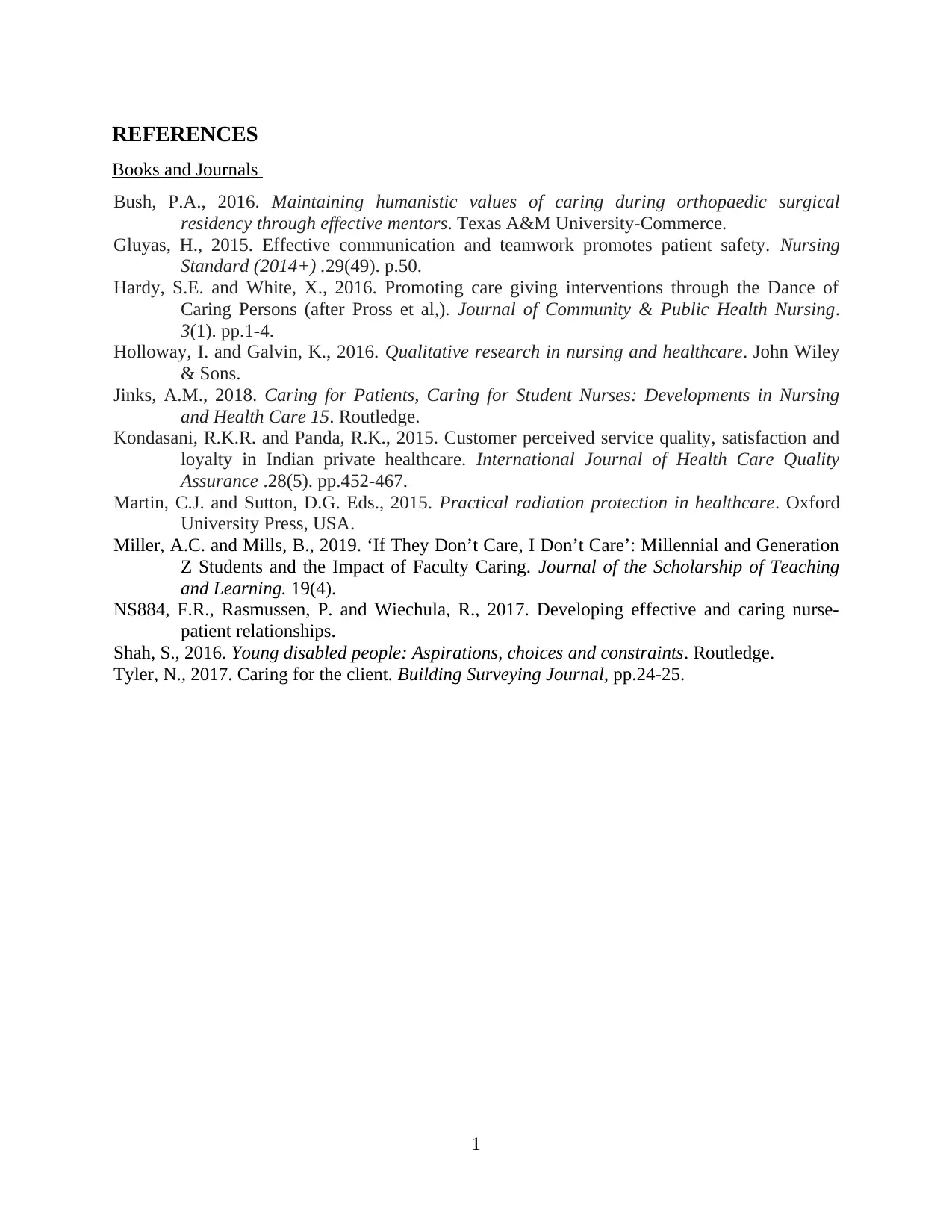
REFERENCES
Books and Journals
Bush, P.A., 2016. Maintaining humanistic values of caring during orthopaedic surgical
residency through effective mentors. Texas A&M University-Commerce.
Gluyas, H., 2015. Effective communication and teamwork promotes patient safety. Nursing
Standard (2014+) .29(49). p.50.
Hardy, S.E. and White, X., 2016. Promoting care giving interventions through the Dance of
Caring Persons (after Pross et al,). Journal of Community & Public Health Nursing.
3(1). pp.1-4.
Holloway, I. and Galvin, K., 2016. Qualitative research in nursing and healthcare. John Wiley
& Sons.
Jinks, A.M., 2018. Caring for Patients, Caring for Student Nurses: Developments in Nursing
and Health Care 15. Routledge.
Kondasani, R.K.R. and Panda, R.K., 2015. Customer perceived service quality, satisfaction and
loyalty in Indian private healthcare. International Journal of Health Care Quality
Assurance .28(5). pp.452-467.
Martin, C.J. and Sutton, D.G. Eds., 2015. Practical radiation protection in healthcare. Oxford
University Press, USA.
Miller, A.C. and Mills, B., 2019. ‘If They Don’t Care, I Don’t Care’: Millennial and Generation
Z Students and the Impact of Faculty Caring. Journal of the Scholarship of Teaching
and Learning. 19(4).
NS884, F.R., Rasmussen, P. and Wiechula, R., 2017. Developing effective and caring nurse-
patient relationships.
Shah, S., 2016. Young disabled people: Aspirations, choices and constraints. Routledge.
Tyler, N., 2017. Caring for the client. Building Surveying Journal, pp.24-25.
1
Books and Journals
Bush, P.A., 2016. Maintaining humanistic values of caring during orthopaedic surgical
residency through effective mentors. Texas A&M University-Commerce.
Gluyas, H., 2015. Effective communication and teamwork promotes patient safety. Nursing
Standard (2014+) .29(49). p.50.
Hardy, S.E. and White, X., 2016. Promoting care giving interventions through the Dance of
Caring Persons (after Pross et al,). Journal of Community & Public Health Nursing.
3(1). pp.1-4.
Holloway, I. and Galvin, K., 2016. Qualitative research in nursing and healthcare. John Wiley
& Sons.
Jinks, A.M., 2018. Caring for Patients, Caring for Student Nurses: Developments in Nursing
and Health Care 15. Routledge.
Kondasani, R.K.R. and Panda, R.K., 2015. Customer perceived service quality, satisfaction and
loyalty in Indian private healthcare. International Journal of Health Care Quality
Assurance .28(5). pp.452-467.
Martin, C.J. and Sutton, D.G. Eds., 2015. Practical radiation protection in healthcare. Oxford
University Press, USA.
Miller, A.C. and Mills, B., 2019. ‘If They Don’t Care, I Don’t Care’: Millennial and Generation
Z Students and the Impact of Faculty Caring. Journal of the Scholarship of Teaching
and Learning. 19(4).
NS884, F.R., Rasmussen, P. and Wiechula, R., 2017. Developing effective and caring nurse-
patient relationships.
Shah, S., 2016. Young disabled people: Aspirations, choices and constraints. Routledge.
Tyler, N., 2017. Caring for the client. Building Surveying Journal, pp.24-25.
1
1 out of 8
Related Documents
Your All-in-One AI-Powered Toolkit for Academic Success.
+13062052269
info@desklib.com
Available 24*7 on WhatsApp / Email
![[object Object]](/_next/static/media/star-bottom.7253800d.svg)
Unlock your academic potential
Copyright © 2020–2025 A2Z Services. All Rights Reserved. Developed and managed by ZUCOL.





